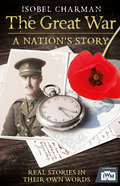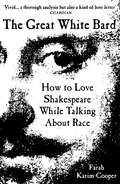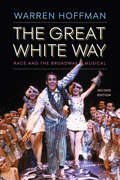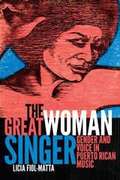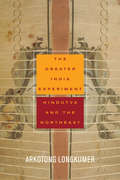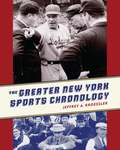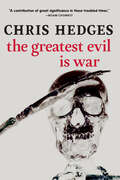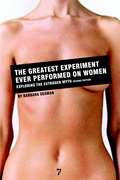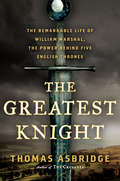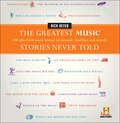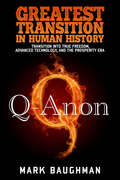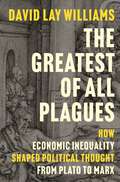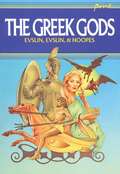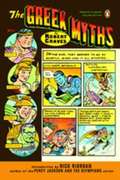- Table View
- List View
The Great War and the Origins of Humanitarianism, 1918-1924
by Bruno CabanesThe aftermath of the Great War brought the most troubled peacetime the world had ever seen. Survivors of the war were not only the soldiers who fought, the wounded in mind and body. They were also the stateless, the children who suffered war s consequences, and later the victims of the great Russian famine of 1921 to 1923. Before the phrases universal human rights and non-governmental organization even existed, five remarkable men and women - Rene Cassin and Albert Thomas from France, Fridtjof Nansen from Norway, Herbert Hoover from the US and Eglantyne Jebb from Britain - understood that a new type of transnational organization was needed to face problems that respected no national boundaries or rivalries. Bruno Cabanes, a pioneer in the study of the aftermath of war, shows, through his vivid and revelatory history of individuals, organizations, and nations in crisis, how and when the right to human dignity first became inalienable.
The Great War in American and British Cinema, 1918–1938: Art Amidst the Ashes (Palgrave Studies in the History of the Media)
by Ryan CoppingThis book recounts the reception of selected films about the Great War released between 1918 and 1938 in the USA and Great Britain. It discusses the role that popular cinema played in forming and reflecting public opinion about the War and its political and cultural aftermath in both countries. Although the centenary has produced a wide number of studies on the memorialisation of the Great War in Britain and to a lesser degree the USA, none of them focused on audience reception in relation to the Anglo-American ‘circulatory system’ of Trans-Atlantic culture.
The Great War: The People's Story (Official TV Tie-In)
by Isobel CharmanDuring the First World War three quarters of a million British people died – a figure so huge that it feels impossible to give it a human context. Consequently we struggle to truly grasp the impact this devastating conflict must have had on people's day-to-day lives. We resort to looking at the war from a distance, viewing its events in terms of their political or military significance. The Great War: The People's Story is different. Like the all-star ITV series it accompanies, it immerses the reader in the everyday experiences of real people who lived through the war. Using letters, diaries, and memoirs – many of which have never previously been published – Isobel Charman has painstakingly reconstructed the lives of people such as separated newly-weds Alan and Dorothy Lloyd, plucky enlisted factory-worker Reg Evans and proudly independent suffragist Kate Parry Frye. A century on, they here tell their stories in their own words, offering a uniquely personal account of the conflict.The Great War: The People's Story is both a meticulously researched piece of narrative history and a deeply moving remembrance of the extraordinary acts of extremely ordinary people.
The Great White Bard: How to Love Shakespeare While Talking About Race
by Farah Karim-CooperSHAKESPEARE: increasingly irrelevant or lone literary genius of the Western canon?'Powerful and illuminating' James Shapiro, author of 1599: A Year in the Life of William Shakespeare, winner of the Baillie Gifford 'Winner of Winners' 2023 Professor Farah Karim-Cooper grew up loving the Bard, perhaps because Romeo and Juliet felt Pakistani to her. But why was being white as a &‘snowy dove&’ essential to Juliet&’s beauty? Combining piercing analysis of race, gender and otherness in beloved plays from Othello to The Tempest with a radical reappraisal of Elizabethan London, The Great White Bard entreats us neither to idealise nor to fossilise Shakespeare but instead to look him in the eye and reckon with the discomforts of his plays, playhouses and society. If we persist in reading Shakespeare as representative of only one group, as the very pinnacle of the white Western canon, then he will truly be in peril. But if we dare to bring Shakespeare down from his plinth, we might unveil a playwright for the twenty-first century. We might expand and enrich his extraordinary legacy. We might even fall in love with him all over again. *** A TIME MAGAZINE BOOK OF THE YEAR 2023 'Insightful, passionate, piled with facts and has a warm, infectious love for theatre and Shakespeare running through every chapter.' ADRIAN LESTER, CBE 'Dive in and your whole cultural landscape will be refreshed and reframed... A challenging, riveting read, The Great White Bard reminds us how powerful the stories we tell can be on our lives.' ADJOA ANDOH 'Vivid… a thorough analysis but also a kind of love letter… Karim-Cooper sees Shakespeare as holding a mirror to this society, with his plays interrogating live issues around race, identity and the colonial enterprise… Her arguments come to feel essential and should be absorbed by every theatre director, writer, critic, interested in finding new ways into the work.&’ GUARDIAN 'There are plenty of books on Shakespeare: but this one is different. This is Shakespeare as we&’ve (most of us) never been willing to see him – and the works emerge from the analysis as newly complicit, powerful and yet recuperative.' EMMA SMITH, AUTHOR OF PORTABLE MAGIC
The Great White Way: Race and the Broadway Musical
by Warren HoffmanBroadway musicals are one of America’s most beloved art forms and play to millions of people each year. But what do these shows, which are often thought to be just frothy entertainment, really have to say about our country and who we are as a nation? Now in a new second edition, The Great White Way is the first book to reveal the racial politics, content, and subtexts that have haunted musicals for almost one hundred years from Show Boat (1927) to Hamilton (2015). This revised edition includes a new introduction and conclusion, updated chapters, as well as a brand-new chapter that looks at the blockbuster musicals The Book of Mormon and Hamilton. Musicals mirror their time periods and reflect the political and social issues of their day. Warren Hoffman investigates the thematic content of the Broadway musical and considers how musicals work on a structural level, allowing them to simultaneously present and hide their racial agendas in plain view of their audiences. While the musical is informed by the cultural contributions of African Americans and Jewish immigrants, Hoffman argues that ultimately the history of the American musical is the history of white identity in the United States. Presented chronologically, The Great White Way shows how perceptions of race altered over time and how musicals dealt with those changes. Hoffman focuses first on shows leading up to and comprising the Golden Age of Broadway (1927–1960s), then turns his attention to the revivals and nostalgic vehicles that defined the final quarter of the twentieth century. He offers entirely new and surprising takes on shows from the American musical canon—Show Boat (1927), Oklahoma! (1943), Annie Get Your Gun (1946), The Music Man (1957), West Side Story (1957), A Chorus Line (1975), and 42nd Street (1980), among others. In addition to a new chapter on Hamilton and The Book of Mormon, this revised edition brings The Great White Way fully into the twenty-first century with an examination of jukebox musicals and the role of off-Broadway and regional theaters in the development of the American musical. New archival research on the creators who produced and wrote these shows, including Leonard Bernstein, Jerome Robbins, Stephen Sondheim, and Edward Kleban, will have theater fans and scholars rethinking forever how they view this popular American entertainment.
The Great Woman Singer: Gender and Voice in Puerto Rican Music
by Licia Fiol-MattaLicia Fiol-Matta traces the careers of four iconic Puerto Rican singers—Myrta Silva, Ruth Fernández, Ernestina Reyes, and Lucecita Benítez—to explore how their voices and performance style transform the possibilities for comprehending the figure of the woman singer. Fiol-Matta shows how these musicians, despite seemingly intractable demands to represent gender norms, exercised their artistic and political agency by challenging expectations of how they should look, sound, and act. Fiol-Matta also breaks with conceptualizations of the female pop voice as spontaneous and intuitive, interrogating the notion of "the great woman singer" to deploy her concept of the "thinking voice"—an event of music, voice, and listening that rewrites dominant narratives. Anchored in the work of Lacan, Foucault, and others, Fiol-Matta's theorization of voice and gender in The Great Woman Singer makes accessible the singing voice's conceptual dimensions while revealing a dynamic archive of Puerto Rican and Latin American popular music.
The Greater Chaco Landscape: Ancestors, Scholarship, and Advocacy
by Ruth M. Van Dyke Carrie C. HeitmanSince the mid-1970s, government agencies, scholars, tribes, and private industries have attempted to navigate potential conflicts involving energy development, Chacoan archaeological study, and preservation across the San Juan Basin. The Greater Chaco Landscape examines both the imminent threat posed by energy extraction and new ways of understanding Chaco Canyon and Chaco-era great houses and associated communities from southeast Utah to west-central New Mexico in the context of landscape archaeology. Contributors analyze many different dimensions of the Chacoan landscape and present the most effective, innovative, and respectful means of studying them, focusing on the significance of thousand-year-old farming practices; connections between early great houses outside the canyon and the rise of power inside it; changes to Chaco’s roads over time as observed in aerial imagery; rock art throughout the greater Chaco area; respectful methods of examining shrines, crescents, herraduras, stone circles, cairns, and other landscape features in collaboration with Indigenous colleagues; sensory experiences of ancient Chacoans via study of the sightlines and soundscapes of several outlier communities; and current legal, technical, and administrative challenges and options concerning preservation of the landscape. An unusually innovative and timely volume that will be available both in print and online, with the online edition incorporating video chapters presented by Acoma, Diné, Zuni, and Hopi cultural experts filmed on location in Chaco Canyon, The Greater Chaco Landscape is a creative collaboration with Native voices that will be a case study for archaeologists and others working on heritage management issues across the globe. It will be of interest to archaeologists specializing in Chaco and the Southwest, interested in remote sensing and geophysical landscape-level investigations, and working on landscape preservation and phenomenological investigations such as viewscapes and soundscapes. Contributors: R. Kyle Bocinsky, G. B. Cornucopia, Timothy de Smet, Sean Field, Richard A. Friedman, Dennis Gilpin, Presley Haskie, Tristan Joe, Stephen H. Lekson, Thomas Lincoln, Michael P. Marshall, Terrance Outah, Georgiana Pongyesva, Curtis Quam, Paul F. Reed, Octavius Seowtewa, Anna Sofaer, Julian Thomas, William B. Tsosie Jr., Phillip Tuwaletstiwa, Ernest M. Vallo Jr., Carla R. Van West, Ronald Wadsworth, Robert S. Weiner, Thomas C. Windes, Denise Yazzie, Eurick Yazzie
The Greater Good: How Philanthropy Drives the American Economy and Can Save Capitalism
by Claire GaudianiA persuasive re-examination of American prosperity and the generosity that has built our nation.For over a century, the United States has stood as a beacon of prosperity and democracy, proof that big business and big dreams could flourish side by side. Yet few Americans realize the crucial role that generosity plays in keeping that fragile balance. And now, with gated communities, oppressive personal debts, shrinking government, and tax and welfare reform crusades, that essential moral glue is at risk of melting away.A leading voice for community development, former Connecticut College president and scholar Claire Gaudiani explores all these issues as she examines American prosperity from the Constitution to the New Economy bust. She traces the push and pull of the robber barons and the progressive movement, the New Deal and the postwar boom, and the Me Decade and the technology revolution, finding that altruism powerfully invests in people, property, and ingenuity. Rather than pitting the capitalists against the populists, Gaudiani brings both sides to the table to reseal this fundamental social contract and provide a blueprint for a just future.The Greater Good is a passionate, pragmatic, and, finally, optimistic manifesto for revitalizing the promise of the American economy.
The Greater India Experiment: Hindutva and the Northeast (South Asia in Motion)
by Arkotong LongkumerThe assertion that even institutions often viewed as abhorrent should be dispassionately understood motivates Arkotong Longkumer's pathbreaking ethnography of the Sangh Parivar, a family of organizations comprising the Hindu right. The Greater India Experiment counters the urge to explain away their ideas and actions as inconsequential by demonstrating their efforts to influence local politics and culture in Northeast India. Longkumer constructs a comprehensive understanding of Hindutva, an idea central to the establishment of a Hindu nation-state, by focusing on the Sangh Parivar's engagement with indigenous peoples in a region that has long resisted the "idea of India." Contextualizing their activities as a Hindutva "experiment" within the broader Indian political and cultural landscape, he ultimately paints a unique picture of the country today.
The Greater New York Sports Chronology
by Jeffrey A. KroesslerJeffrey A. Kroessler's comprehensive and entertaining time line stretches from the pastoral entertainments of the Dutch to the corporate captivity of professional sports. He chronicles events ranging from the truly heroic to the heartbreaking, from moments of municipal greatness to inescapable social change. Through it all he plants the world of sport at the very center of New York's story. Fully illustrated, The Greater New York Sports Chronologycovers the spectacle of blood sports like bullbaiting to the birth of baseball, the now-forgotten six-day pedestrian contests, and today's New York City Marathon. Alongside great moments like the Mets' "amazin'" World Series win in 1969, Joe Louis's historic bouts with Max Schmeling, Jackie Robinson's breaking of baseball's color line, and Secretariat's remarkable Triple Crown win at Belmont, we encounter the point-shaving scandals of college basketball and the corrupting influence of organized crime in professional boxing. Beyond immortals like Lou Gehrig and Joe Namath, we also find such once well known figures as Joe Lapchick, Marty Glickman, Gertrude Ederle, and Toots Shor. Year by year, this chronology recounts chess matches, America's Cup races, dog shows, golf tournaments, polo matches, tennis games, and more. Kroessler describes the historic venues, boxing arenas, gyms, stadiums, ballparks, and racetracks that have come and gone, yet made New York the undisputed capital of American sport. Witnessing it all, of course, are the greatest fans in the world.
The Greater New York Sports Chronology
by Jeffrey KroesslerJeffrey A. Kroessler's comprehensive and entertaining time line stretches from the pastoral entertainments of the Dutch to the corporate captivity of professional sports. He chronicles events ranging from the truly heroic to the heartbreaking, from moments of municipal greatness to inescapable social change. Through it all he plants the world of sport at the very center of New York's story.Fully illustrated, The Greater New York Sports Chronology covers the spectacle of blood sports like bullbaiting to the birth of baseball, the now-forgotten six-day pedestrian contests, and today's New York City Marathon. Alongside great moments like the Mets' "amazin'" World Series win in 1969, Joe Louis's historic bouts with Max Schmeling, Jackie Robinson's breaking of baseball's color line, and Secretariat's remarkable Triple Crown win at Belmont, we encounter the point-shaving scandals of college basketball and the corrupting influence of organized crime in professional boxing. Beyond immortals like Lou Gehrig and Joe Namath, we also find such once well known figures as Joe Lapchick, Marty Glickman, Gertrude Ederle, and Toots Shor. Year by year, this chronology recounts chess matches, America's Cup races, dog shows, golf tournaments, polo matches, tennis games, and more. Kroessler describes the historic venues, boxing arenas, gyms, stadiums, ballparks, and racetracks that have come and gone, yet made New York the undisputed capital of American sport. Witnessing it all, of course, are the greatest fans in the world.
The Greatest Brigade: How the Irish Brigade Cleared the Way to Victory in the American Civil War
by Thomas J. CraughwellA history of the impressive, predominantly Irish American brigade of the Union Army and their role in its victory over the Confederacy.Faugh a Ballagh! Clear the Way!This is the story of a band of heroes that covered the Yankee retreat at Bull Run, drove the Confederates from the Sunken Road at Antietam, and made charge after charge up Marye’s Heights at Fredericksburg. The gallantry of the Irish Brigade won them the admiration of the high command of both North and South, earned them seven Medals of Honor, and after the war, went a long way to helping the Irish assimilate into the American mainstream.Shouting their Gaelic battle cry, the men of the Irish Brigade charged across the bloodiest battlefields of the Civil War and into the realm of legend. The Greatest Brigade is a grand narrative history of these Irishmen who fought in every major battle in the Eastern Theater of the Civil War, including Bull Run, Antietam, Fredericksburg, Gettysburg, the Wilderness, and Appomattox.Praise for The Greatest Brigade“An exciting journey through the major battles of the Civil War alongside the members of the famed Irish Brigade. Well researched, compellingly written, filled with fascinating illustrations, and with a story that holds the reader with a “bulldog grip,” Thomas Craughwell has written a regimental history that deserves to be on every Civil War lover’s bookshelf.” —Jason Emerson, author of The Madness of Mary Lincoln and Lincoln the Inventor“This engrossing book will appeal both to Civil War buffs and to those interested in the Irish American experience.” —Library Journal“A paean to the Irish immigrants who fought for their adopted homeland. . . . This spirited hagiography marches through the battles fought by the Army of the Potomac’s justly renowned Irish Brigade at quickstep pace. Each chapter reads like an episode of a History Channel documentary.” —Historynet
The Greatest Evil is War
by Chris HedgesAn unflinching indictment of the horror and obscenity of war by one of our finest war correspondents.Drawn from experience and interviews by Pulitzer-prize-winner Chris Hedges, this book looks at the hidden costs of war, what it does to individuals, families, communities and nations.In fifteen short chapters, Chris Hedges astonishes us with his clear and cogent argument against war, not on philosophical grounds or through moral arguments, but in an irrefutable stream of personal encounters with the victims of war, from veterans and parents to gravely wounded American serviceman who served in the Iraq War, to survivors of the Holocaust, to soldiers in the Falklands War, among others. Hedges reported from Sarajevo, and was in the Balkans to witness the collapse of the Soviet Union. In 2002 he published War Is a Force that Gives Us Meaning, which the Los Angeles Times described as &“the best kind of war journalism… bitterly poetic and ruthlessly philosophical&” and the New York Times called &“a brilliant, thoughtful, timely, and unsettling book.&” In the twenty years since, Hedges has not wanted to write another book on the subject of war—until now, with the outbreak of war in Ukraine. It is important again to be reminded who are the victors of the spoils of war and of other unerring truths, not only in this war but in all modern wars, where civilians are always the main victims, and the tools and methods of war are capable of so much destruction it boggles the mind. This book is an unflinching indictment of the horror and obscenity of war by one of our finest war correspondents.
The Greatest Experiment Ever Performed on Women: Exploding the Estrogen Myth
by Barbara SeamanWith the ardent tone of a close friend, Barbara Seaman draws on forty years of journalistic research to expose the "menopause industry" and shows how estrogen therapy often causes more problems--including breast cancer, heart attack, and stroke--than it cures. The Greatest Experiment Ever Performed on Women tracks the well-intentioned discovery of synthetic estrogen through the unconscionable and misleading promotion of a dangerous drug.
The Greatest Knight
by Thomas Asbridge<P>A thrillingly intimate portrait of one of history's most illustrious knights--William Marshal--that vividly evokes the grandeur and barbarity of the Middle Ages <P>William Marshal was the true Lancelot of his era--a peerless warrior and paragon of chivalry--yet over the centuries, the spectacular story of his achievements passed from memory. Marshal became just one more name in the dusty annals of history. Then, in 1861, a young French scholar named Paul Meyer made a startling discovery during an auction of rare medieval manuscripts. Meyer stumbled upon the sole surviving copy of an unknown text--the first contemporary biography of a medieval knight, later dubbed the History of William Marshal. This richly detailed work helped to resurrect Marshal's reputation, putting flesh onto the bones of this otherwise obscure figure, yet even today William Marshal remains largely forgotten. <P>As a five-year-old boy, Marshal was sentenced to execution and led to the gallows, but this landless younger son survived his brush with death and went on to train as a knight. Against all odds, Marshal rose through the ranks--serving at the right hand of five English monarchs--to become a celebrated tournament champion, a baron and politician and, ultimately, a regent of the realm. <P>William Marshal befriended the great figures of his day, from Richard the Lionheart and Eleanor of Aquitaine to the infamous King John, and helped to negotiate the terms of Magna Carta--the first "bill of rights." By the age of seventy, the once-forsaken child had been transformed into the most powerful man in England, yet he was forced to fight in the front line of one final battle, striving to save the kingdom from a French invasion in 1217. <P>In The Greatest Knight, renowned historian Thomas Asbridge draws upon the thirteenth-century biography and an array of other contemporary evidence to present a compelling account of William Marshal's life and times. Asbridge follows Marshal on his journey from rural England onto the battlefields of France, to the desert castles of the Holy Land and the verdant shores of Ireland, charting the unparalleled rise to prominence of a man bound to a code of honor, yet driven by unquenchable ambition. <P>This knight's tale lays bare the brutish realities of medieval warfare and the machinations of the royal court, and draws us into the heart of a formative period of our history, when the West emerged from the Dark Ages and stood on the brink of modernity. It is the story of one remarkable man, the birth of the knightly class to which he belonged and the forging of the English nation. <P><b>A New York Times Bestseller</b>
The Greatest Music Stories Never Told: 100 Tales from Music History to Astonish, Bewilder, and Stupefy (The\greatest Stories Never Told Ser.)
by Rick BeyerThis collection of little-known stories from music history is “an effortless summer read for the music lover” (Houston Chronicle).The author of the highly successful History Channel series The Greatest Stories Never Told returns with new historic tales, this time focusing on amazing music stories that aren’t taught in the average classroomRick Beyer plums the vast archives of the History Channel to deliver a treasure trove of obscure and fascinating stories to delight and entertain. The Greatest Music Stories Never Told continues the series tradition with short, fascinating tales accompanied by an array of stunning and diverse photographs from around the globe.The Greatest Music Stories Never Told illuminates the origins of a fascinating range of music topics, from instruments and styles to composers and technological advances—all which show us how little we really know. Guaranteed to astonish, bewilder, and stupefy, this all new volume will appeal not only to history buffs but to pop culture audiences and music fans of all ages and stripes.“We picked up the book expecting to inflate our egos, reinforcing the myth that we know everything there is to know about music history. Short answer--we were wrong, very wrong.” —LA Weekly“A little book you won’t be able to put down.” —Florida Times-Union “History like you’ve never read it before . . . Amusing.” —The Tennessean“Lively, offbeat and surprising.” —Denver Rocky Mountain News“Fascinating.” —Dallas Morning News“Full of tasty morsels . . . A delightful book to arm one for the next dull cocktail party.” —Chicago Tribune
The Greatest Transition In Human History: Transition into True Freedom, Advanced Technology, and The Prosperity Era
by Mark BaughmanKnowledge is power. Real truth is freedom. Freedom is what our Founding Fathers wanted to create as the beacon of light to the world in 1776. America was to be the example of what humanity could be. Was that really achieved? The Greatest Transition in Human History tells the real story of America over the past over 200 years - the heartbreak, false-flag wars, hidden technology, power, corruption, and manipulation. Does the American citizen have real Freedom as the great Constitution and Bill of Rights intended? The Greatest Transition in Human History is the real emotion story of great Americans and patriots standing up for these great rights. These freedoms were taken for granted by so many - for many fell asleep and did not participate as much as we should have, including myself for many years. No more, for I work for humanity, and freedom. I want that real Freedom Bell to ring for all. For in the oath to a military person sworn in to our armed forces, they are to fight any enemy both foreign and domestic. The Greatest Transition in Human History is the story of brave people standing up for individual freedoms and rights worldwide, in the Greatest Secret War ever.
The Greatest of All Plagues: How Economic Inequality Shaped Political Thought from Plato to Marx
by David Lay WilliamsHow the great political thinkers have persistently warned against the dangers of economic inequalityEconomic inequality is one of the most daunting challenges of our time, with public debate often turning to questions of whether it is an inevitable outcome of economic systems and what, if anything, can be done about it. But why, exactly, should inequality worry us? The Greatest of All Plagues demonstrates that this underlying question has been a central preoccupation of some of the most eminent political thinkers of the Western intellectual tradition.David Lay Williams shares bold new perspectives on the writings and ideas of Plato, Jesus, Thomas Hobbes, Jean-Jacques Rousseau, Adam Smith, John Stuart Mill, and Karl Marx. He shows how they describe economic inequality as a source of political instability and a corrupter of character and soul, and how they view unchecked inequality as a threat to their most cherished values, such as justice, faith, civic harmony, peace, democracy, and freedom. Williams draws invaluable insights into the societal problems generated by what Plato called &“the greatest of all plagues,&” and examines the solutions employed through the centuries.An eye-opening work of intellectual history, The Greatest of All Plagues recovers a forgotten past for some of the most timeless books in the Western canon, revealing how economic inequality has been a paramount problem throughout the history of political thought.
The Grecanici of Southern Italy: Governance, Violence, and Minority Politics
by Stavroula PipyrouThe Grecanici are a Greek linguistic minority in the Calabria region of Italy, remnants of a population that has resided there since late antiquity. Their language represents a holdover from the Middle Ages, at least, and possibly even to the Greek colonies of the classical period. For decades the Grecanici passionately fought to be recognized by the Italian state as an official linguistic minority, finally achieving this goal in 1999. Violence, corruption, and mismanagement are inextricable parts of the social fabric, but Grecanici have crafted the means to invert hegemonic culture and participate in the power games of minority politics.The Grecanici of Southern Italy provides a comprehensive ethnography that examines the ways the minority developed and sustain enduring cultural forms of solidarity and relatedness. Stavroula Pipyrou proposes the concept of "fearless governance" to describe overlapping and sometimes contradictory systems of power, authority, and relational networks that enable the Grecanici to achieve political representation at the intersection of local, national, and global encounters. Refuting easy assumptions of top-down governmental influence, Pipyrou shows how the Grecanici find political representation through the European Union and UNESCO, state policy, civic associations, family networks and illegal organizations; not being afraid to take risks, incur wrath, lose friends, or risk death in challenging the political status-quo.
The Greek City 7 Its Institutions (The\history Of Civilization Ser.)
by GlotzFirst published in 2006. Routledge is an imprint of Taylor & Francis, an informa company.
The Greek Gods
by Ned Hoopes Dorothy Evslin Bernard EvslinThis book is an excellent introduction to Greek mythology, and includes a glossary, afterword, and bibliography.
The Greek Myths
by Robert Graves Ross Macdonald Rick RiordanRobert Graves, classicist, poet, and unorthodox critic, retells the Greek legends of gods and heroes for a modern audience And, in the two volumes of The Greek Myths, he demonstrates with a dazzling display of relevant knowledge that Greek Mythology is "no more mysterious in content than are modern election cartoons." His work covers, in nearly two hundred sections, the creation myths; the legends of the births and lives of the great Olympians; the Theseus, Oedipus, and Heracles cycles; the Argonaut voyage; the tale of Troy, and much more. All the scattered elements of each myth have been assembled into a harmonious narrative, and many variants are recorded which may help to determine its ritual or historical meaning, Full references to the classical sources, and copious indexes, make the book as valuable to the scholar as to the general reader; and a full commentary on each myth explains and interprets the classical version in the light of today's archaeological and anthropological knowledge.
The Greek Myths
by Robert GravesCombines in a single volume the complete text of the definitive two-volume classic, citing all the ancient myths.
The Greek Myths
by Robert GravesThe Greek Myths is the definitive and comprehensive edition of Robert Graves's classic imaginative and poetic retelling of the Greek myths. 'Icarus disobeyed his father's instructions and began soaring towards the sun, rejoiced by the lift of his great sweeping wings. Presently, when Daedalus looked over his shoulder, he could no longer see Icarus; but scattered feathers floated on the waves below. . . 'Including many of the greatest stories ever told - the labours of Hercules, the voyage of the Argonauts, Theseus and the minotaur, Midas and his golden touch, the Trojan War and Odysseus's journey home - Robert Graves's superb and comprehensive retelling of the Greek myths for a modern audience has been regarded for over fifty years as the definitive version. With a novelist's skill and a poet's eye, Graves draws on the entire canon of ancient literature, bringing together all the elements of every myth into one epic and unforgettable story. Ideal for the first time reader, it can be read as a single, continuous narrative, while full commentaries, with cross-references, interpretations, variants and explanations, as well as a comprehensive index of names, make it equally valuable as a work of scholarly reference for anyone seeking an authoritative and detailed account of the gods, heroes and extraordinary events that provide the bedrock of Western literature. The result is a classic among classics, a treasure trove of extraordinary tales and a masterful work of literature in its own right. 'Among the most generous, self-willed, unseemly and brilliant writers of our century' New York Times Robert Graves (1895 - 1985) was a novelist, poet, historian, critic and translator, author of some 140 books, and one of the greatest figures of 20th century British literature. Alongside The Greek Myths, his most famous works include the historical novels I, Claudius and Claudius the God and his First World War memoir Goodbye to All That. His friendship with fellow war poet Siegfried Sassoon was the subject of Pat Barker's novel Regeneration.


